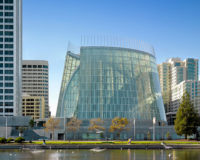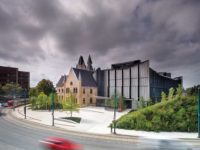Mus'oParc Al'sia
Au Naturel: A concrete drum wrapped in a larch wood screen provides a distinctive orientation center for a historic battlefield.






















Architects & Firms
Alise-Sainte-Reine, France
A circular building treated as a monolithic, self-contained volume can be unforgivingly oppressive. The Hirshhorn Museum—a poured concrete donut plopped onto the National Mall in Washington, D.C., in 1974 by Gordon Bunshaft of Skidmore, Owings & Merrill—certainly reminds us of that danger. Yet, using that simple concept (and material), architect Bernard Tschumi recently created a dynamically quirky structure for MuséoParc Alésia's Interpretation Center in France.
For more than a decade, Tschumi, who has offices in New York and Paris, has been exploring curved concrete forms combined with different materials—especially in France. In both the Zénith concert hall and exhibition complex in Rouen and the Zénith concert hall in Limoges, he designed the facade and roof as one continuous envelope. While the earlier project probed the notion of wrapping a concrete structure with stainless steel, the second did so with polycarbonate and wood.
But with the Alésia's interpretation center, 37 miles northwest of Dijon, Tschumi has turned to the purer geometry of the concrete drum, which has been around at least since the Coliseum in Rome (82 a.d.), to explore that form's expressiveness. By superimposing a lattice of larch wood onto it, Tschumi has given the drum a sense of scale and detail that avoids the pitfalls of the Hirshhorn. In addition, the planted trees jauntily sprouting from the roof lend the whole composition a mysterious aura.
Inside the center you find a spiraling stair, much like Frank Lloyd Wright's ramp for the Solomon R. Guggenheim Museum, but easier to climb because of the steps. And at Alésia, you end up on an upper-level terrace with a panoramic view of the countryside and the village of Alise-Sainte-Reine.
On this historic site, in a pastoral area of Burgundy southwest of Paris, Vercingetorix, chief of the Gauls, was besieged in 52 b.c. by Julius Caesar, who was busy transforming the Roman Republic into an empire. While the interpretive center appears at first glance to be a romantic ruin, its circular form actually echoes the trenches and fortifications Caesar built to win the final battle over the Gauls. Caesar had devised two circular cordons of trenches and stockades around the oppidum, or fortified hill town, of Alésia. The inner ring, 9 miles in circumference, entrapped the Gauls; the outer one, 14 miles around, prevented external reinforcements from coming to Vercingetorix's aid. The siege lasted two months, and the rest, as they say, is history.
Archaeological excavations initiated in the mid–19th century and bolstered by digs in the 1990s gave Alésia, now Alise-Sainte-Reine, incentive to bring its legendary past to public attention. Tschumi's proposal, which began with a competition in 2002, actually calls for two cylindrical buildings—of which the first to be completed is the four-story, 86,111-square-foot interpretion center that opened this past March near Caesar's fortifications. His second structure, a three-story, 70,000-square-foot archaeological museum, will be completed in 2016 about a mile away, on the slopes of Mont Auxois, where Vercingetorix and his troops were trapped in their stronghold. Unlike the wood-screened center, the round concrete museum will be wrapped in the same local yellow-tinged limestone (Pierre de Bourgogne) as used for the stone walls of the Gallic ramparts. As Tschumi explains, “The two buildings, with the circular configurations, are in a dialogue,” which relates to the concentric circles of the battlefield and the oppidum.
The larch wood for the interpretation center came from Germany—where ringed elements were bent by steam—and was assembled on-site, using galvanized steel pins and sleeve connections. The entrance opens into a large rotunda topped by a concrete disc, which is actually the floor of a 154-seat lecture hall. The disc is supported by slender concrete columns, some perpendicular, others tilting quixotically. “I wanted to keep the rotunda sober and pure,” says Tschumi, “but I didn't want the columns to seem too monumental.”
The architect had white sand mixed into the concrete for the visible portions of the interior, and he used metal formwork for the walls and columns. The warped surfaces of the ramp, however, demanded a more labor-intensive wood formwork for a smooth pour.
The attenuated spiraling stair leads visitors up to exhibition and orientation areas and conference rooms. As it winds up and around, daylight, filtering in from glazing at the top and side walls, gives the place a faint Piranesian air: Translucent glass floors at the upper reaches of the spiral add to the interior's ethereality.
While the 12,917 square feet of exhibition space display models, multimedia terminals, dioramas, films, and reconstructed battle equipment—devices to give visitors an idea of the fateful siege when the Gauls fell to Caesar's veni vidi vici mind-set—the actual high point in the processional tour comes when you arrive on the roof terrace. There you look over partially rebuilt battlements (with a narrower gap between the two rings) and an expansive, softly rolling terrain. Landscape architect Michel Desvigne designed a grassy circular bed planted with white birches and oaks on the terraces, where trees grow no more than 25 feet high. (A rainwater recovery and filtering system fits in with the center's energy measures, as does the energy savings of the wood brise-soleil.)
The wood lattice enclosure that swathes the concrete and gray glass structure gives it a protective, timeless quality. Since the thick filigree hides the solidity of the concrete, and the tree limbs and leaves spring up from the roof, its masklike quality is all the more provocative. Here the mask humanizes the architecture (or should we say naturalizes it) with its use of timber and the diagonal pattern of its component parts. It beckons us to enter and become familiar with the contents within—to become part of history and nature.
Completion Date: March 2012
Gross square footage: 8,000 m2 (site 37 hectares)
Total Project cost: € 22M
Architect:
Bernard Tschumi Architects
227 W. 17th Street
New York, NY 10011
Ph: 212-807-6340
Fax: 212-242-3693
PeopleOwner: Conseil Général, Côte d’Or, Bourgogne
Architect
Personnel in architect's firm who should receive special credit: Interior designer: Exhibition design: Scene, Guy-Claude Francois
Engineer(s): Structural: BEA Ingénierie MEP: BET Choulet Electrical: Cegelec
Consultant(s): Acoustical: Cial, Jean-Luc Lecoq
Other: Wood Facade: J. Natterer, consulting engineer Cost Consultant: Bureau Michel Forgue Safety Engineer: PCA Coordinator: IOSIS Grand Est Control Bureau: Alpes Contrôle Safety Coordinator: PMM Photographer(s): Iwan Baan, Christian Richters
CAD system, project management, or other software used: |
Products
Structural system
Exterior cladding Wood: Timber Frame Lattice Facade: Mélèze, Ochs Moisture barrier: SMAC
Glazing
Doors
Interior finishes Demountable partitions: DBS, Placoplatre Cabinetwork and custom woodwork: C3B, Sst MEN Paints and stains: Bonglet Floor and wall tile: Casal Grande – Marthé, Del Toso Resilient flooring: Chape Béton Ciré – Grepi, Pascual
Special interior finishes unique to this project:
Furnishings Auditorium Seats: Quinette Gallay - Mussidan Other furniture: Museum Store: Vitu
Lighting Exterior: Philips
Dimming System or other lighting controls:
Conveyance
Plumbing
Other unique products that contribute to sustainability: Landscape contractors: Duc & Prefeuf / FCE |

















